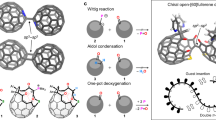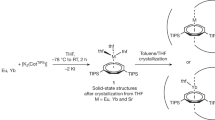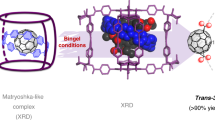Abstract
Cyclic oligomers comprising strongly interacting redox-active monomer units represent an unknown, yet highly desirable class of nanoscale materials. Here we describe the synthesis and properties of the first family of molecules belonging to this compound category—differently sized rings comprising only 1,1′-disubstituted ferrocene units (cyclo[n], n = 5–7, 9). Due to the close proximity and connectivity of centres (covalent Cp–Cp linkages; Cp = cyclopentadienyl) solution voltammograms exhibit well-resolved, separated 1e– waves. Theoretical interrogations into correlations based on ring size and charge state are facilitated using values of the equilibrium potentials of these transitions, as well as their relative spacing. As the interaction free energies between the redox centres scale linearly with overall ring charge and in conjunction with fast intramolecular electron transfer (∼107 s−1), these molecules can be considered as uniformly charged nanorings (diameter ∼1–2 nm).
This is a preview of subscription content, access via your institution
Access options
Subscribe to this journal
Receive 12 print issues and online access
$259.00 per year
only $21.58 per issue
Buy this article
- Purchase on Springer Link
- Instant access to full article PDF
Prices may be subject to local taxes which are calculated during checkout




Similar content being viewed by others
References
Francl, M. A. Molecule with a ring to it. Nature Chem. 7, 6–7 (2015).
Steed, J. W. & Atwood, J. L. Supramolecular Chemistry 2nd edn (Wiley-Blackwell, 2009).
Grossmann, B. et al. Seven doubly bridged ferrocene units in a cycle. Angew. Chem. Int. Ed. Engl. 36, 387–389 (1997).
Herbert, D. E. et al. Redox-active metallomacrocycles and cyclic metallopolymers: photocontrolled ring-opening oligomerization and polymerization of silicon-bridged [1]ferrocenophanes using substitutionally-labile Lewis bases as initiators. J. Am. Chem. Soc. 131, 14958–14968 (2009).
Xu, L., Wang, Y. X., Chen, L. J. & Yang, H. B. Construction of multiferrocenyl metallacycles and metallacages via coordination-driven self-assembly: from structure to functions. Chem. Soc. Rev. 44, 2148–2167 (2015).
Arduini, A. et al. Solvent- and light-controlled unidirectional transit of a nonsymmetric molecular axle through a nonsymmetric molecular wheel. Chem. Eur. J. 18, 16203–16213 (2012).
Kano, S., Tada, T. & Majima, Y. Nanoparticle characterization based on STM and STS. Chem. Soc. Rev. 44, 970–987 (2015).
Stark, W. J., Stoessel, P. R., Wohlleben, W. & Hafner, A. Industrial applications of nanoparticles. Chem. Soc. Rev. 44, 5793–5805 (2015).
Albrecht, T. Electrochemical tunnelling sensors and their potential applications. Nature Commun. 3, 829 (2012).
Albrecht, T., Mertens, S. F. L. & Ulstrup, J. Intrinsic multistate switching of gold clusters through electrochemical gating. J. Am. Chem. Soc. 129, 9162–9167 (2007).
Kealy, T. J. & Pauson, P. L. A new type of organo-iron compound. Nature 168, 1039–1040 (1951).
Miller, S. A., Tebboth, J. A. & Tremaine, J. F. Dicyclopentadienyliron. J. Chem. Soc. 632–635 (1952).
Rausch, M. D., Fischer, E. O. & Grubert, H. The aromatic reactivity of ferrocene, ruthenocene and osmocene. J. Am. Chem. Soc. 82, 76–82 (1960).
Long, N. J. Metallocenes: Introduction to Sandwich Complexes (Wiley-Blackwell, 1997).
Watts, W. E. The [1,1]ferrocenophane system. J. Am. Chem. Soc. 88, 855–856 (1966).
Katz, T. J., Acton, N. & Martin, G. [1n]ferrocenophanes. J. Am. Chem. Soc. 91, 2804–2805 (1969).
Mueller-Westerhoff, U. T. & Swiegers, G. F. A synthesis of the cyclic ferrocene tetramer [1]4ferrocenophane. Chem. Lett. 23, 67–68 (1994).
Perevalova, E. G. & Nesmeyanova, O. A. Preparation of biferrocenyl by the Ullmann reaction. Dokl. Akad. Nauk 130, 1093–1094 (1960).
Rausch, M. D., Roling, P. V. & Siegel, A. Formation of ferrocene oligomers from mixed Ullmann reactions of halogenoferrocenes. J. Chem. Soc. D 502–503 (1970).
Roling, P. V. & Rausch, M. D. Formation of 1,1′-oligomeric ferrocenes from mixed Ullmann reactions of haloferrocenes. J. Org. Chem. 37, 729–732 (1972).
Neuse, E. W. & Loonat, M. S. Synthesis of ferrocenylruthenocene. Transition Metal Chem. 6, 260–263 (1981).
Goeltz, J. C. & Kubiak, C. P. Facile purification of iodoferrocene. Organometallics 30, 3908–3910 (2011).
Roling, P. V. & Rausch, M. D. Formation of 1,2-oligomeric ferrocenes from Ullmann reactions of iodoferrocenes. J. Org. Chem. 141, 195–204 (1977).
Izumi, T. & Kasahara, A. The formation of 1,1′-oligomeric ferrocenes from chloromercuriferrocene and bis(chloromercuri)ferrocene. Bull. Chem. Soc. Jpn 48, 1955–1956 (1975).
Bomparola, R., Davies, R. P., Gray, T. & White, A. J. P. Structures of lithium ferrocenylenecuprates and their oxidative coupling reactions. Organometallics 28, 4632–4635 (2009).
Nishihara, H., Hirao, T., Aramaki, K. & Aoki, K. Redox properties of hepta(1,1′-dihexylferrocenylene). Synth. Met. 84, 935–936 (1997).
Bednarik, L. & Neuse, E. W. Oligonuclear ruthenocene complexes. J. Am. Chem. Soc. 45, 2032–2033 (1980).
Ingram, G., Jaitner, P. & Schwarzhans, K. E. Synthesis and characterization of hetero-oligometallocenes containing ruthenocene and osmocene. Z. Naturforsch. B 45, 781–784 (1990).
Andre, M. et al. Synthesis and preparative HPLC-separation of heteronuclear oligometallocenes. Isolation of cations of rhodocenylferrocene, 1,1′-dirhodocenylferrocene, and 1-cobaltocenyl-,1′-rhodocenylferrocene. Chromatographia 30, 543–545 (1990).
Schottenberger, H., Ingram, G., Obendorf, D. & Tessadri, R. Ferrocene-substituted nickelocenes via ferrocenylcyclopentadienides. Synlett 905–907 (1991).
Breuer, R. & Schmittel, M. 1,1′-Biferrocenylenes—the more redox stable ferrocenes! New derivatives, corrected NMR assignments, redox behavior, and spectroelectrochemistry. Organometallics 31, 1870–1878 (2012).
LeVanda, C. et al. Bis(fulvalene)diiron, its mono- and dications. Intramolecular exchange interactions in a rigid system. J. Am. Chem. Soc. 98, 3181–3187 (1976).
Shekurov, R. P. et al. Synthesis and structure of ferrocenylphosphinic acids. J. Org. Chem. 766, 40–48 (2014).
Shekurov, R., Miluykov, V., Kataeva, O., Tufatullin, A. & Sinyashin, O. Crystal structure of cyclic tris(ferrocene-1,1′-diyl). Acta Crystallogr. E 70, m318–m319 (2014).
Santi, S. et al. Synthesis of the prototypical cyclic metallocene triad: mixed-valence properties of [(FeCp)3(trindenyl)] isomers. Angew. Chem. Int. Ed. 47, 5331–5334 (2008).
Katz, T. J. & Slusarek, W. The trindene trianion. J. Am. Chem. Soc. 102, 1058–1063 (1980).
Zhang, S., Zhang, D. & Liebeskind, L. S. Ambient temperature, Ullmann-like reductive coupling of aryl, heteroaryl, and alkenyl halides. J. Org. Chem. 62, 2312–2313 (1997).
Babudri, F., Cardone, A., Farinola, G. M. & Naso, F. A versatile copper-induced synthesis of fluorinated oligo(para-phenylenes). Tetrahedron 54, 14609–14616 (1998).
John, D. E. et al. New bi(tetrathiafulvalenyl) derivatives and their radical cations: synthetic and X-ray structural studies. J. Mater. Chem. 10, 1273–1279 (2000).
Zonta, C., Fabris, F. & De Lucchi, O. The pyrrole approach toward the synthesis of fully functionalized cup-shaped molecules. Org. Lett. 7, 1003–1006 (2005).
Fabris, F., Zonta, C., Borsato, G. & De Lucchi, O. Benzocyclotrimers: from the Mills−Nixon effect to gas hosting. Acc. Chem. Res. 44, 416–423 (2011).
Inkpen, M. S., Du, S. Driver, M., Albrecht, T. & Long, N. J. Oxidative purification of halogenated ferrocenes. Dalton Trans. 42, 2813–2816 (2013).
Barrière, F. & Geiger, W. E. Use of weakly coordinating anions to develop an integrated approach to the tuning of ΔE1/2 values by medium effects. J. Am. Chem. Soc. 128, 3980–3989 (2006).
Camire, N., Mueller-Westerhoff, U. T. & Geiger, W. E. Improved electrochemistry of multi-ferrocenyl compounds: investigation of biferrocene, terferrocene, bis(fulvalene)diiron and diferrocenylethane in dichloromethane using [NBu4][B(C6F5)4] as supporting electrolyte. J. Org. Chem. 637–639, 823–826 (2001).
Bard, A. J. & Faulkner, L. Y. Electrochemical Methods 2nd edn (Wiley, 2004).
Richardson, D. E. & Taube, H. Mixed-valence molecules: electronic delocalization and stabilization. Coord. Chem. Rev. 60, 107–129 (1984).
Sokol, W. F., Evans, D. H., Niki, K. & Yagi, T. Reversible voltammetric response for a molecule containing four non-equivalent redox sites with application to cytochrome c3 of Desulfovibrio vulgaris, strain Miyazaki. J. Electroanal. Chem. Interfacial Electrochem. 108, 107–115 (1980).
Masuda, Y. & Shimizu, C. Solvent effect on intramolecular electron transfer rates of mixed-valence biferrocene monocation derivatives. J. Phys. Chem. A 110, 7019–7027 (2006).
Brown, G. M. et al. Oxidation-state and electron-transfer properties of mixed-valence 1,1′-polyferrocene ions. Inorg. Chem. 14, 506–511 (1975).
Ohanian, H. C. & Markert, J. T. Physics for Engineers and Scientists 3rd edn (W.W. Norton & Company, 2007).
Acknowledgements
M.S.I., T.A. and N.J.L. acknowledge the Leverhulme Trust (RPG 2012-754) for funding. The authors are grateful to the referees for useful comments and suggestions concerning the extent of charge delocalization in these materials.
Author information
Authors and Affiliations
Contributions
M.S.I., T.A. and N.J.L. conceived the work and designed the experiments. M.S.I. synthesized the materials and performed the solution electrochemical measurements. A.J.P.W. performed the X-ray crystallographic experiments. S.S., M.L. and R.F.W. performed the UV/vis/NIR spectroscopy experiments. All authors contributed to writing the paper.
Corresponding authors
Ethics declarations
Competing interests
The authors declare no competing financial interests.
Supplementary information
Supplementary information
Supplementary information (PDF 2179 kb)
Supplementary information
Crystallographic data for compound cyclo[6]-benzene (CIF 362 kb)
Supplementary information
Crystallographic data for compound cyclo[6]-toluene (CIF 305 kb)
Rights and permissions
About this article
Cite this article
Inkpen, M., Scheerer, S., Linseis, M. et al. Oligomeric ferrocene rings. Nature Chem 8, 825–830 (2016). https://doi.org/10.1038/nchem.2553
Received:
Accepted:
Published:
Issue Date:
DOI: https://doi.org/10.1038/nchem.2553
This article is cited by
-
Synthesis and properties of cyclic sandwich compounds
Nature (2023)
-
The supramolecular redox functions of metallomacromolecules
Journal of Leather Science and Engineering (2020)
-
Synthesis, characterization and quantum chemical study of optoelectronic nature of ferrocene derivatives
Bulletin of Materials Science (2020)
-
Synthesis, antimicrobial and photoelectric potency of new ferrocene-based congeners
Monatshefte für Chemie - Chemical Monthly (2018)
-
Main-chain metallopolymers at the static–dynamic boundary based on nickelocene
Nature Chemistry (2017)



